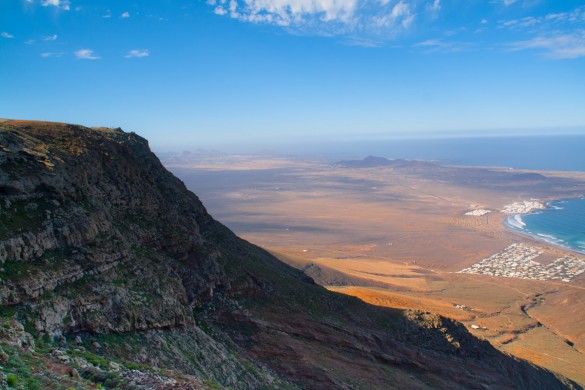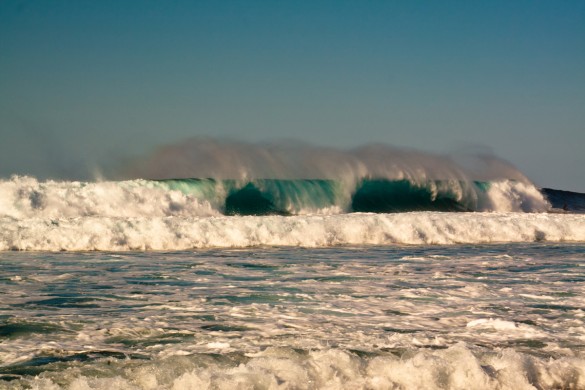Where I come from, Lanzarote is known to be granny paradise. Every year around the beginning of November the march of the lemmings starts when every aged person in the possession of a medium piggy bank moves his or her lazy ass to either the Spanish Costas or to the Canary Islands.
This sounds like a place you don’t want to be, right? I had the same feeling for quite some time, until now, Lanzarote appeared to be the only destination with guaranteed sunny weather, where I could get with a relatively cheap flight. So I’ve put all of my prejudices aside and went over there, to have a look if it’s as bad as it appeared in my imagination.
How to get there

Close to Arrecife, the “capital” of Lanzarote, is the only airport in the island. Arrecife airport is supporting quite a lot European airline companies, which makes it possible to get there easily from about everywhere in Europe. Intercontinental visitors will have to fly to a major European hub first – like Frankfurt, London, Brussels, Madrid – and catch a flight from there.
As often, my choice of airline went to Ryanair because it remains the cheapest solution and one of my favourite short distance airlines. No kidding. Some time ago, a second terminal was built in Arrecife to support the inter-island flights, which makes it easy to travel from one island to another. Island hopping is also possible by ferry, but from Lanzarote only Fuerteventura is reachable directly by boat. From Fuerteventura it is possible to take the ferry further to Gran Canaria or Tenerife.
When to go

When to go to a place mostly depends on the weather, and when it comes to weather conditions, Lanzarote is one of Europe’s most pleasant destinations. Here are some figures:
- Average temperature: 20 to 30 degrees Celsius during the whole year
- Average rainfall: 150mm per year
- Average hours of sun: 2500 to 3000 per year
- On the North-West side of the island there may be some heavier winds, but this is often pleasant in the sunshine and great for surfers.
- During the summer months, from June to September, the temperature can get quite high, especially when the wind comes from the East, from the Moroccan desert.
How to get around
You’ve arrived in Arrecife airport, now what?
There are several options. You could take the bus to Arrecife centre or Puerto del Carmen or you could take a taxi to about everywhere you want or you could rent a car. If you pay enough to a tour guide they could probably also pick you up by camel, but that is an option I leave you to investigate. The major bus line of the island is called Arrecife Bus and connects to every major town, passing through about every other town. There are regular schedules and the price will be something between 1 and 2 euro for a ride.
As some parts of the island are uninhabited and the prettiest parts seemed quite remote, we opted for the car rental solution. After a couple of chats with the ladies of the car rental companies, I figured out that Payless car could provide us the cheapest option, a Fiat Panda for 18€ a day (taxes and insurance included). An extra advantage is that Lanzarote has a duty free status, which means that fuel costs a lot less than in other parts of Europe.
Where to sleep

When people look at a travel brochure for Lanzarote, the only accommodation available appears to be hotels. Hotels hotels hotels. But this is a false image promoted by the hotel industry. In fact there are three main types of accommodation:
1. The hotels: of course there are hotels, the majority of them will be found in the tourist towns – the playas as they say. Because the landscape of Lanzarote is protected, you won’t find very high hotel buildings. Most of them are only three stories high or provide rooms in a bungalow style.
2. The apartments: there are a lot of apartments for rent for both long and short periods. People often think that you need to stay at least a month to get an apartment, but this is not true. We’ve rented one for two days. The advantage is that they are not expensive and that you have the tools to cook your own meals.
3. The Casa Rural: or what is called a Bed & Breakfast anywhere else in the world. Casas rurales are a more expensive option but they come with a lot of advantages too. There is breakfast, you often stay in a non-touristy region, there are few other guests and there is always someone around to help you, give advice, solve problems, translate things or to have a chat with.
We have tried all three possibilities.
On our first and second night we stayed in casa rural El Rancho Grande in Tinajo. This was a place I had found on the internet and of which I had written down the address. And it was a great place. The owner, Thomas, a Belgian guy who is living on Lanzarote for more than 22 years, likes to tell everything he knows about the island. When you get home after a long day of walking this may appear as a disadvantage. On our second day in the casa rural I figured out that the price I had found on the internet – 36€ – was per person and not per room, so this place was 72€ per night for both of us. Even though the place was really great, 72€ was out of budget, so after our second night we had to find something different.
Which we found in the beach town of La Santa. La Santa is a quite popular surfer destination, and the local surf school Kalufa Surf provides apartments for 35€ a night – for 2 persons! The one we got was quite big, with a terrace with sea view. Sweet!
For our last night we decided that it was better to sleep a bit closer to the airport so we moved to Puerto del Carmen, one of the three major tourist locations.
“When in Rome, do as the Romans do”, we thought, and we checked in into one of the cheapest hotels of the area. Hotel Costa Volcan is a three star accommodation which is available for only 25€ a night. Which is cheap. The toll you pay is that you’re surrounded by elderly and package holiday people. If you have a pool view room, be careful before you look down because 75 years and older boobs have been spotted regularly around the pool.
What and where to eat
The typical dish of Lanzarote is called Papas Arrugadas, which means “wrinkled potatoes”. Something like cooked potatoes in their shell which are served with a traditional sauce called mojo. there are different versions of mojo but every one of them contains a lot of garlic. Fish, shellfish and goat – both the meat and the cheese – also appear often on the menu.
Every town has a couple of restaurants but the seaside towns have the most. Often with sea view terraces. One of the best places we ate was in La Santa on the main road. The name was something with “dolphins”, you will find it. Also the best tapas bar we’ve been to – and we’ve been to a lot – was in La Santa. From outside it looks like a cellar under a restaurant, but it is a tapas bar. If you’d go there, their red house wine is great and their baked fish tapas are really delicious.
Food for two and a bottle of red house wine made our budget something between 25 and 40 euros lighter, something I could easily live with.
What to do

First thing you need to know is that Lanzarote is a volcanic island. If you like long walks in the nature between grass, trees and flowers, you might want to consider spending your holidays somewhere else.
A volcanic landscape means that there is more or less nothing green, except for the odd planted palm tree. But that doesn’t mean that it’s an ugly place. Volcanic grounds are very colourful, they vary from red to orange to something yellowish to different shades of brown to black. So you’ll have to consider long walks between the volcanoes this time, but you will probably not regret it.
With a size of 60km by 25km, Lanzarote is a small island. If you decide to rent a car you can more or less see the whole island in three days. If you hurry. But this is not the climate for stressed people so it took us six days to see about 75 percent of the island.
There is a lot of free stuff to do: Walk through the small fishing villages like El Barquito or Orzola, enjoy the spectacular views from the hills in the north, be amazed by the big waves in La Santa, stroll the beach of Caleta la Famara, visit the small villages in the mainland, or go to the market on Sunday morning in Teguise, which is supposed to be the largest one in Europe – and the most touristy one too if you ask me. When you get bored from the market, walk up the hill to the castle and see the ocean on both sides of the island, go to one of the three tourist towns – Puerto del Carmen, Playa Blanca or Playa Teguise – and watch the tourists. Have a swim in the ocean, hunt for deserted places, visit the cliffs of El Golfo, taste wine in one of the bodegas in the south, go to the salt mine of Salinas, or ave a look at the Monumento al Campesino, or do some duty free shopping – the shopping is free, not the buying.
Really, there are a lot of things to do to keep you – or at least me – busy for about a week.
Even though Lanzarote is not promoted as a location for independent travelers, it is enjoyable to give it a try. It’s easy to get around, most inhabitants speak next to Spanish also English, prices of food and booze are affordable if you stay away from the tourist areas, the weather is good and the atmosphere is laid-back.